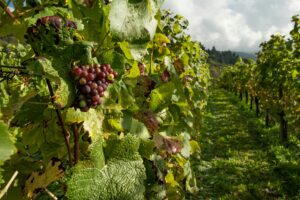The litany of German white wine begins with Riesling, but doesn’t end there.
Although much of the country’s claim to fine wine fame has been founded on what is arguably the world’s finest Riesling, Germany cultivates at least fifteen different white wine varietals. In fact, nearly two-thirds of the country’s total wine production is made up of whites ranging from Pinot Gris to Sauvignon Blanc. The country’s cooler climate is well-suited to the production of white wines that are lean, acidic, and supremely age-worthy.
Let’s look at the top five German white wine and what makes them worth the buck.
Riesling
All lists of German white wine begin with the celebrated Riesling. Although it originated in the Rhine region, it is now cultivated across all 13 German wine regions – but mainly in Mosel Valley and Pfalz. In fact, the country is home to the world’s largest vineyard area dedicated to Riesling – over 23,000 hectares or 25% of Germany’s total vineyard area.
German Riesling comes in a number of variants with diverse nuances – from the light and sparkling Rieslingsekt to the lusciously sweet Trockenbeerenauslese. A bone-dry Riesling is labelled ‘trocken’, while a semi-dry one is ‘Halbtrocken’. The flavour profile varies with the soil and microclimate; for instance, Mosel produces the crisp and lighter wines while Pfalz yields the rich and full-bodied ones.
A typical Riesling will have pronounced acidity, crisp minerality, floral aromas, and tropical fruit flavours. The grape is susceptible to gray rot, which can result in premature grape drop.
Try: The 1971 Egon Muller Scharzhofberger Riesling Beerenauslese
Müller-Thurgau
Germany’s everyday wine is the light and refreshing Müller-Thurgau. It is a cross between the Riesling and the Madeleine Royale grapes, initially bred in 1882 by Professor Hermann Müller. Today, it is grown across Germany and accounts for about 12% of the country’s total vineyard area, only second to the Riesling.
The well-drained soils of the Rheinhessen, Baden, and Palatinate are particularly well-suited for the Müller-Thurgau. The grapes ripen early and produce full-bodied mildly acidic floral wine that can be sweet or dry. The best vintages balance the wine’s peach-like sweetness with rhubarb-like crunchy bitterness.
Try: The 2019 Staffelter Hof – Jan Matthias Klein It’s Muller Time Sandersstruck
Pinot Gris and Pinot Blanc (Grauburgunder and Weissburgunder)
The Pinot Gris grape is a lighter mutation of the Pinot Noir, while the Pinot Blanc is a white mutation of the Pinot Gris. The former produces a dry and acidic medium-bodied wine with notes of nuts and stone fruits – think almonds, pears, and pineapples. Germany is the third biggest producer of Pinot Gris in the world in terms of vineyard area.
Pinot Blanc is less complex as compared to Pinot Gris’s texture and colour development. It is fresh in acidity and delicate in flavours, with floral and slightly nutty aromas, making it an ideal summer wine. Steadily growing in popularity over the recent years, the Pinot Blanc vineyards in Germany account for the highest in the world.
Try: The 2017 Weingut Salwey Oberrotweiler Eichberg Grauburgunder Grosses Gewachs or the 2012 Okonomierat Rebholz ‘Im Sonnenschein’ Weissburgunder Grosses Gewachs
Silvaner
One of Germany’s lesser known but delightful white wines is the temperamental Silvaner. It is difficult to grow but ripens early and produces a high-quality versatile wine. With its juicy fruit flavours, subtle aromas, and slight herbaceous notes, Silvaner makes for a great spring wine and can be paired well with food. It has an oily texture on the palate, which is complemented by its crisp acidity. Although it is currently undervalued, Silvaner used to be one of the most important grape varieties in 19th-century Germany.
Try: The 2019 Konni & Evi Silvaner Saale-Unstrut
Kerner
Riesling’s ‘little cousin’, Kerner is its crossing with the red Trollinger (Schiava) grape. Introduced in the early 1970s, this native German grape saw its peak of popularity in 1992. Since its plantings have been declining, there is an influx of Kerner from Alto Adige in Italy replacing German Kerner.
Another easy everyday wine, the lean and minerally Kerner can be either dry or sweet. Notes of tropical fruits, almonds and spices make it distinctly aromatic.
Try: The 1975 Weingut Furst zu Hohenlohe-Oehringen Verrenberger ‘Verrenberg’ Kerner Auslese
Go beyond the top five and explore Germany’s other white wines like Bacchus, Scheurebe, Gutedel, and Chardonnay, or check out our list of must-try German white wines to add to your collection!







